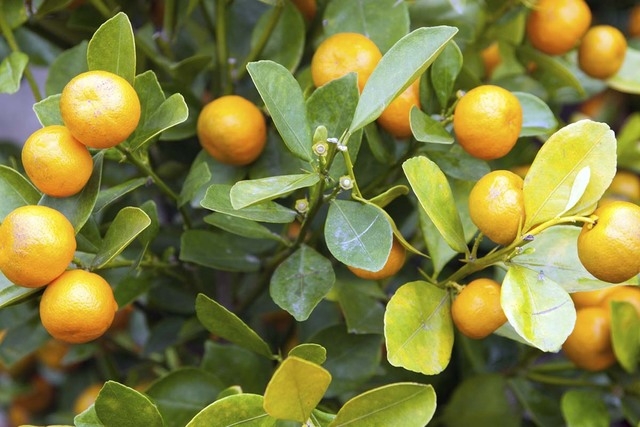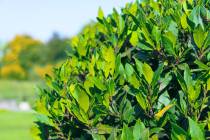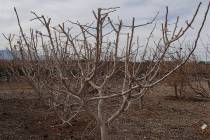Temperature, irrigation troubles can hamper kumquats
Q: This last year we have had very little fruit on our kumquat, although the tree had been ample with fruit before. The tree appears to be healthy, just no fruit. The only difference I can think of is that in previous years I covered the tree whenever the temperature was below freezing. However, this past year I only covered it when the temperature fell to the upper 20s.
A: Kumquat is a very winter-hardy citrus and can survive most winter temperatures here without any problems, provided it is in a sheltered spot. The key question you have to ask yourself is whether it produced any flowers or not this past year. No flowers equals no fruit.
The major reasons for early fruit drop are temperature and irrigation problems. If we have freezing temperatures or if the plants become water-stressed from insufficient water, they tend to drop whatever fruit and flowers they produced. Flower buds and fruits are much less hardy to freezing temperatures than the plant itself.
Kumquat may produce fruit all year but tend to produce fruit in the spring and fall and through the winter. If the plant does get winter damage, you would see plant dieback.
When dieback occurs, the plant will regrow to the height it was before it had damage and produce very few flowers. Once it reestablishes its previous size it will then begin to flower again and produce fruit.
If there were some spring freezes the flower buds would be killed before anything else would show damage. This would tend to minimize fruit production. If the plant receives a lot of fertilizer, particularly nitrogen, it may tend to put on new growth with few flowers and little, if any, fruit.
Q: I’d like to plant a few manageable nitrogen-fixing plants and go about fertilization of my fruit trees without chemicals. Can you recommend any?
A: There is a misunderstanding about what nitrogen-fixing plants can and can’t do. Nitrogen-fixing plants, plants that can take nitrogen from the air and convert it to nitrogen that a plant can use, do not produce enough nitrogen to support other plants. Some don’t even produce enough for themselves.
If you are looking for a trickle of nitrogen to your trees, perhaps selecting the right nitrogen-fixing plant might provide a little benefit. But most nitrogen-fixing crops or plants require additional applications of nitrogen to perform at acceptable levels.
Nitrogen-fixing plants give the greatest benefit when used as a green manure crop. Green manure crops are plants that are grown to a certain stage of maturity and then recycled back into the soil. These plants take nitrogen from the air, and also nitrogen from the soil, and put it into a form that can slowly release it to the plant as it decomposes in the soil.
The decomposition of nitrogen-fixing plants in soils allows the nitrogen that they have captured from the air and the soil to be slowly rereleased over time. In other words, they take nitrogen that otherwise might be lost to the environment and give crops a chance to use it.
If you are a permaculturist or a gardener who values sustainability more than appearance or total production of his garden, you might be able to appreciate what some of these nitrogen-fixing plants can do in producing food.
But if you are expecting to have a level of production and visual quality of fruit equal to what you could buy from a grocery store or a farmers market, you will be disappointed. This does not mean that the fruit will not taste good or that it will have fewer nutrients, however.
Q: I am very excited about planting four pomegranates: ambrosia, purple heart, hotuni-zigar, and sirenvyi.
A: Out of your four pomegranates I have experience only with ambrosia. It is one of the earliest pomegranates but to be honest I am not a big fan of its flavor or appearance and neither did anyone else that tried it. It did seem to improve a little bit in flavor after sitting in the refrigerator for a couple of weeks after harvest.
Pomegranates I would recommend for you to try include sweet, wonderful, eversweet, parfianka, sharp velvet, Grenada and Utah sweet.
Q: The new growth on my citrus trees (lemon, oranges, and grapefruit) are starting to curl as they grow. They are watered every three days, 12 gallons per watering. I fed them every six weeks starting at the end of February with a balanced citrus fertilizer. Any thoughts or suggestions?
A: In our climate, this is nothing to be concerned about. We don’t have a lot of citrus here so many of the insects that might cause curling or cupping of leaves are not commonly present here.
Most likely, what you are seeing is growth in response to our heat. I think the curled leaves’ outer edges became damaged or their growth slowed compared with the rest of the leaves and new growth began to distort.
You should not see this in new growth in the spring. In other parts of the country where citrus is more common, this could be an insect-related problem or an irrigation problem.
In our case, and because it’s happening on so many of your citrus, it is most likely heat-related and a temporary problem that will not affect production.
Q.:I have just been told that I have “grubs” in my plants. What do I do to get rid of them?
A: Grubs are larvae or immature forms of insects, usually beetles. Common examples are the June beetles and the green metallic beetle.
The immature form of this insect causes damage by feeding on plant roots around 6 to 10 inches deep in the soil. They have been reported in compost piles, feeding on Lantana roots, rose roots, lawns and other plants. Signs that they are damaging plants is a general lack of growth or even dieback.
You have two approaches to controlling grubs; applying conventional pesticides or organic pesticides. The conventional pesticides usually act more quickly than the organic pesticides. However, organic pesticides usually give you a longer period of control. Common conventional pesticides include the insecticide Sevin and Permethrin in the ingredients.
Conventional pesticides come in liquid or granules. Both of these chemicals are applied to the soil above the roots and lightly watered into the soil where these insects are feeding. They usually kill these insects in a matter of hours. Be sure to read and follow the label directions.
Organic pesticides rely on other living organisms to give you some measure of control. They can be dry or granular products, usually either a bacterium that kills these grubs after the grub eats them or a specialized nematode that attacks this particular insect.
Both of these products are fairly specific to this particular pest and don’t cause problems with earthworms or honeybees and other nontarget species. These beneficial nematodes do not damage plants.
Organic pesticides are also applied to the soil and watered in. You would lightly water both of these products into the soil. Do not overwater or you can push the chemical beyond the depth where the grubs are feasting.
These grubs are immature forms of flying insects. This means that this pest can be back in future years and you will have to retreat the area.
Bob Morris is a horticulture expert living in Las Vegas and professor emeritus for the University of Nevada. Visit his blog at xtremehorticulture.blogspot.com. Send questions to Extremehort@aol.com.


























